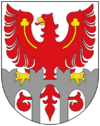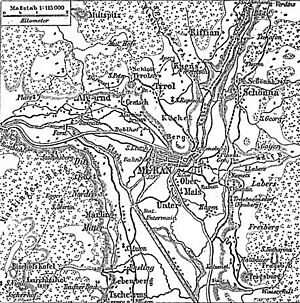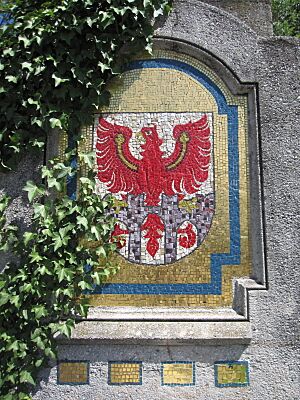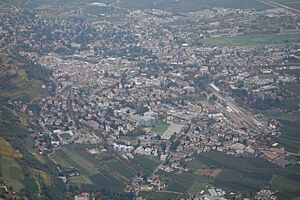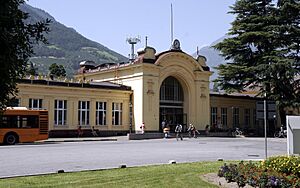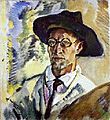Merano facts for kids
Quick facts for kids
Meran/Merano
Maran (Ladin)
|
||
|---|---|---|
| Comune di Merano Stadtgemeinde Meran |
||
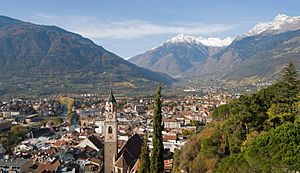 |
||
|
||
| Country | Italy | |
| Region | Trentino-Alto Adige/Südtirol | |
| Province | South Tyrol (BZ) | |
| Frazioni | Centro (Altstadt), Maia Alta (Obermais), Maia Bassa (Untermais), Quarazze (Gratsch), Sinigo (Sinich), Labers | |
| Area | ||
| • Total | 26.34 km2 (10.17 sq mi) | |
| Elevation | 325 m (1,066 ft) | |
| Population
(30-06-2018)
|
||
| • Total | 41,051 | |
| • Density | 1,558.50/km2 (4,036.5/sq mi) | |
| Demonym(s) | Meranese/Meraner | |
| Time zone | UTC+1 (CET) | |
| • Summer (DST) | UTC+2 (CEST) | |
| Postal code |
39012
|
|
| Dialing code | 0473 | |
| Patron saint | St Nicholas | |
| Saint day | December 6 | |
Merano (also called Meran in German) is a town in South Tyrol, Northern Italy. It is known for its spa resorts, which are places where people go to relax and improve their health using special waters. The town is in a valley surrounded by mountains that are over 3,300 meters (10,900 feet) high. It sits at the start of the Passeier Valley and the Vinschgau area.
Many famous people, like writer Franz Kafka and Empress Elisabeth of Austria, have enjoyed living in Merano. They loved its mild climate and peaceful atmosphere.
Contents
About Merano's Name
The town is called Merano in Italian and Meran in German. Both names are used in English. In the Ladin language, which is spoken by some people in the region, the name is Maran. The official name of the town is Comune di Merano in Italian and Stadtgemeinde Meran in German.
Merano's History
The area around Merano has been home to people for a very long time, even since 3000 BC. This is known because of old stone monuments called menhirs found there. The town's story really began in 15 BC. That's when the Romans arrived and built a road station called Statio Maiensis.
How Merano Grew
The first time Merano was mentioned in writing was in the year 857 AD, when it was called Mairania. Later, in the 1200s, the Counts of Castle Tyrol made Merano a city. They also made it the capital of their area, the County of Tyrol.
In 1363, the House of Habsburg family took over the county. In 1420, Duke Friedrich IV moved the main court to Innsbruck. Even though Merano was still officially the capital until 1848, it became less important. It lost its role as a major trading center between Italy and Germany. The important coin mint was also moved away in 1477.
Merano in Modern Times
Merano became important again during the Tyrolean Rebellion of 1809. This was a fight against the French army. In that year, a group of local farmers won a battle against the French and Bavarian forces on a hill above the city. However, their rebellion was eventually stopped.
After World War I, in 1919, Merano became part of the Kingdom of Italy. This happened because of the Treaty of Saint-Germain-en-Laye.
During World War II, when the Nazis controlled the region (1943–1945), many Jewish people living in Merano were taken away and killed in concentration camps.
Merano's Coat of Arms
A coat of arms is like a special symbol for a city. Merano's coat of arms shows a red eagle, which is the symbol of Tyrol. The eagle sits on a wall with four points and three arches, which represent the city. This symbol has been used since the 1300s.
After World War I, when Merano became part of Italy, it got a new coat of arms in 1928. It looked similar but had five points on the wall. These five points stood for the different areas that were added to the city by the Italian government at that time. After World War II, the old, historical coat of arms was brought back.
What to See in Merano
Merano has many interesting places to visit. You can see the old medieval city gates, like the Vinschgauer Tor, Passeirer Tor, and Bozener Tor. There's also the medieval Ortenstein tower, often called Pulverturm (which means "powder tower").
The main churches are the Gothic St. Nicholas' Church and the St. Barbara's Chapel. Both were built in the 1400s. The Princely Castle (Landesfürstliche Burg), also from this time, was once home to Archduke Sigismund of Austria.
The Steinerner Steg is a stone bridge built in the 1600s that crosses the Passer river.
Merano became very popular as a spa town, especially after Empress Elisabeth of Austria started visiting. From the 1800s, you can see the Civic Theatre, the Kurhaus (a grand building for spa guests), and the Empress Elisabeth Park. The arched Wandelhalle walkways along the river are also famous.
After Merano became part of Italy in 1919, the new city hall was built in the 1920s.
Outside the city, you can visit Trauttmansdorff Castle and its beautiful gardens. Inside the castle, there's a Museum of Tourism that shows how tourism grew in the area. Tirol Castle is also nearby.
Merano's Climate
Merano has a mild climate. It's officially an oceanic climate, but it's also close to being humid subtropical. This means it has warm summers and cool winters.
In summer, the average daytime temperatures are between 27 and 30 °C (81-86 °F). At night, temperatures usually drop to 12 to 15 °C (54-59 °F). In winter, the average daytime temperatures are between 6 and 10 °C (43-50 °F). At night, they usually drop to between -4 and -2 °C (25-28 °F). August is the wettest month, and February is the driest.
| Climate data for Merano (1983–2017) | |||||||||||||
|---|---|---|---|---|---|---|---|---|---|---|---|---|---|
| Month | Jan | Feb | Mar | Apr | May | Jun | Jul | Aug | Sep | Oct | Nov | Dec | Year |
| Record high °C (°F) | 21 (70) |
23 (73) |
27 (81) |
31 (88) |
37 (99) |
39 (102) |
40 (104) |
40 (104) |
35 (95) |
29 (84) |
21 (70) |
19 (66) |
40 (104) |
| Mean daily maximum °C (°F) | 6.4 (43.5) |
9.6 (49.3) |
15.1 (59.2) |
18.8 (65.8) |
23.5 (74.3) |
27.2 (81.0) |
29.6 (85.3) |
28.6 (83.5) |
23.7 (74.7) |
17.9 (64.2) |
10.9 (51.6) |
6.5 (43.7) |
18.2 (64.8) |
| Daily mean °C (°F) | 1.3 (34.3) |
3.8 (38.8) |
8.4 (47.1) |
12.0 (53.6) |
16.4 (61.5) |
19.8 (67.6) |
21.9 (71.4) |
21.3 (70.3) |
17.1 (62.8) |
12.1 (53.8) |
5.7 (42.3) |
1.7 (35.1) |
11.8 (53.2) |
| Mean daily minimum °C (°F) | −4.0 (24.8) |
−2.3 (27.9) |
1.6 (34.9) |
5.0 (41.0) |
9.3 (48.7) |
12.4 (54.3) |
14.2 (57.6) |
13.9 (57.0) |
10.2 (50.4) |
6.1 (43.0) |
0.5 (32.9) |
−3.3 (26.1) |
5.3 (41.5) |
| Record low °C (°F) | −19 (−2) |
−13 (9) |
−12 (10) |
−4 (25) |
−2 (28) |
2 (36) |
2 (36) |
1 (34) |
−2 (28) |
−8 (18) |
−10 (14) |
−13 (9) |
−19 (−2) |
| Average precipitation mm (inches) | 26.4 (1.04) |
24.5 (0.96) |
36.9 (1.45) |
61.7 (2.43) |
80.0 (3.15) |
94.7 (3.73) |
83.8 (3.30) |
96.3 (3.79) |
72.3 (2.85) |
74.9 (2.95) |
84.5 (3.33) |
37.9 (1.49) |
773.8 (30.46) |
| Source: Landeswetterdienst Südtirol | |||||||||||||
Merano's Culture
Food and Drink
Merano is famous for its wines, both white and red. You can see vineyards (grape farms) all around the city. The local red wine is called Meraner Leiten. There are also many apple orchards, and apples from Merano are sent all over Europe. The Forst Brewery, located near the city, makes popular beers sold throughout Italy and Europe.
Cultural Events
Merano hosts several events every year:
- Asfaltart (a street art festival)
- Festival MeranOJazz (a jazz music festival)
- Meraner Musikwochen (Merano Music Weeks)
- Christmas market Merano
- Merano WineFestival
Every two years, the Merano Poetry Prize (Lyrikpreis Meran) is held in the city.
Famous People from Merano
Many interesting people have connections to Merano:
- Arbeo of Freising (died 784), an early writer and bishop.
- Johann Baptista Ruffini (1672–1749), a salt trader.
- Pius Zingerle (1801–1881), an Austrian expert on Eastern cultures.
- Ludwig Freiherr von und zu der Tann-Rathsamhausen (1815–1881), a Bavarian general.
- Oskar Freiherr von Redwitz (1823–1891), a German poet who lived in Merano.
- Ignaz Vincenz Zingerle (1825–1892), a poet and scholar.
- Peretz Smolenskin (1842–1885), a writer who supported the idea of a Jewish homeland.
- Hermann von Tappeiner (1847–1927), a doctor who used light therapy.
- Sir Rudolf Carl von Slatin (1857–1932), a soldier and Inspector General of Sudan.
- Ferdinand Behrens (1862-1925), a painter known for city portraits.
- Leo Putz (1869–1940), a Tyrolean painter.
- Prince Emmanuel, Duke of Vendome (1872–1931), a French royal.
- Richard Steidle (1881–1940), a lawyer and leader of a group in Tyrol.
- Erna Ellmenreich (1885–1976), an opera singer.
- Oswald Menghin (1888–1973), a university professor and historian.
- Ludwig Bemelmans (1898–1962), an American writer and illustrator of children's books, famous for the Madeline books.
- Silvius Magnago (1914–2010), a politician who helped create the special self-governing status for South Tyrol.
- Annelies Reinhold (1917–2007), a film actress.
- Bargil Pixner (1921–2002), a monk and archaeologist.
- Norbert Untersteiner (1926–2012), a pioneer in polar science.
- Alberto Lizzio (1926–1999), a conductor.
- Irène Galter (1931–2018), an actress.
- Maria Bertolini (1931–2022), a politician.
- Arnaldo Di Benedetto (born 1940), a literary critic.
- Franco D'Andrea (born 1941), a jazz pianist.
- Lino Capolicchio (1943–2022), an actor and film director.
- Cuno Tarfusser (born 1954), a judge at the International Criminal Court.
- Gloria Guida (born 1955), an Italian actress.
- Rudolf Stingel (born 1956), an artist.
- Luca Dipierro (born 1973), an animator and writer.
Sports Figures
- Norberto Oberburger (born 1960), a weightlifter who won a gold medal at the 1984 Olympics.
- Edith Gufler (born 1962), a sport shooter who won a silver medal at the 1984 Olympics.
- Günther Steiner (born 1965), a motorsports engineer.
- Armin Zöggeler (born 1974), a luge champion with many Olympic and world championship medals.
- Dominik Paris (born 1989), an alpine skier.
- Daniel Frank (born 1994), an ice hockey player.
- Daniel Grassl (born 2002), a figure skater who competed in the 2022 Winter Olympics.
Merano's Economy
Merano is a popular place for tourists, especially from Germany and Italy. In the summer, there are often concerts along the river. There are also many great walking paths around the city and in the nearby mountains. One popular area is "Meran/o 2000," which also offers skiing in winter. You can reach Merano by train from Bolzano, and the railway continues to Malles.
Merano's Society
According to a 2011 survey, about half of the people living in Merano speak German as their first language (50.47%). The other half mostly speak Italian (49.06%). A small number (0.47%) speak Ladin.
Sports in Merano
A special move in chess, called the Meran Variation of the Semi-Slav Defense, is named after the city. This is because it was used successfully in a chess tournament held in Merano in 1924. In 1981, the World Chess Championship match between Anatoly Karpov and Viktor Korchnoi also took place in Merano. The musical Chess even has a song called "Merano."
The city's handball team, Pallamano Merano, is one of the best in Italy, winning a national championship in 2005. The ice hockey team has won two national championships.
Every September, the Gran Premio Merano horse race takes place at the Maia Racecourse. This is Italy's most famous Steeplechase race, where horses jump over obstacles.
Merano has also hosted the ICF Canoe Slalom World Championships in 1953, 1971, and 1983. A well-known move in slalom paddling, called the 'Merano' move, was created here because of a difficult gate on the course.
Twin Towns
Merano has a "twin town" relationship with:
 Salzburg, Austria
Salzburg, Austria
Images for kids
See also
 In Spanish: Merano para niños
In Spanish: Merano para niños


